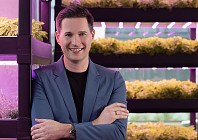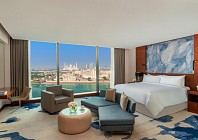As the lights come up and the first strains of Andrea Bocelli’s Con te Partiro float over Dubai Fountain, a hush gathers over the audience and the show begins. Neck hairs stand on end as jets of water shoot 240 feet into the air and dance with astonishing precision to the music.
The magnificent creation is the work of Mark Fuller’s WET Design, the company responsible for the Bellagio Fountains in Las Vegas and a significant number of equally impressive projects across the globe. Blending his passion for H20 with complex scientific principles, not to mention a penchant for the dramatic, Fuller and his team have become pioneers in the world of water technology, setting the benchmark for water-in-motion projects everywhere.
How did you end up in this unique business?
I was working for the Walt Disney Company in the special effects department, creating special effects for their theme parks – Epcot Center at Disneyland. For the most part water fountains at that time were fairly traditional. I took the work that I had done in my college thesis, in which you take the water molecules that move in a stream of water and make them move exactly parallel at exactly the same speed, sort of like a water laser beam. It produces a stream of water that looks like a frozen piece of glass. We did that at the Epcot Center, and it became wildly popular. After that I said, ‘Wow, nobody’s doing much of this’, so we decided to start our own company.
Do you have a lot of competition now?
There’s certainly been a tremendous rise in the popularity of water features in luxury properties. When we started the company, one of the biggest obstacles was that we would have to convince the developer to consider putting a water fountain in the middle of a hotel or a park or a mixed-use development. It wasn’t very common. Now it’s hard to think of a hotel or casino that doesn’t have a water feature of some sort and we kind of influenced that. There are a lot of other companies doing similar things, but I don’t really think of them as competitors per se, because we have a very different approach.
So you were basically the trendsetters in terms of water features?
Well, put it this way: I look at my iPhone, and I think about how three years ago there wasn’t a mobile phone that had this interactive screen, and it was so innovative at the time. Now it’s become a staple of mobile phones.
You’ve done several world-renowned projects like the Bellagio Fountains and the Dubai Fountain, which are acclaimed as the best in the business. What kind of budgets do you have to play with on projects like those?
The budgets vary greatly. The Bellagio was a multi-million dollar project that took years, but we also do small things that take less time. At the end of the day, the clients are running a business, so we need to come up with something that is a smart investment for our clients.
Can you explain some of the innovative designs that you’ve come up with and how they’ve changed the business forever?
One of the first innovations that is so ubiquitous now is the idea of the fountains that come out of little holes in the ground. The very first one we did was in Dallas, Texas. It may be everywhere now, but it was radical at the time. With the Dubai Fountain, the jets that come out and ‘dance’ are controlled by underwater robots, and their movements were developed by a choreographer.
Several very talented choreographers work on our team, and sometimes we bring in someone from outside, like Aaron Cash, choreographer of High School Musical, who has won several Emmys. He did the choreography for the fountain at the Bellagio, and he said, ‘I can get the same kind of movement from your water jets as I can from a person – whether it be comedy or a dramatic moment'. In order to make it a really emotional experience, it has to be a sophisticated movement.
How much energy is used to power these mega-fountains?
We’ve done a tremendous amount of innovation in energy saving. The Bellagio is a good example. There are these streams of water that are blasted into the sky with the use of compressed air. That uses about 20 percent of the energy that would be used to create the same fountain if you were to use traditional pumps. And the lighting that we use, particularly if you watch the Dubai Fountain, all those lights use an incredible amount of energy, but we developed the technology to switch each light off for a split second, which saves a great amount of energy and money. We really pride ourselves in being leaders in that aspect.
What new innovations will you be incorporating into your newest projects?
In Salt Lake city, Utah, it gets very cold in the winter. We are doing several fountains there, which I can’t really tell you much about, but they are opening next March. They will be the most popular water features in the world. When all the other fountains in the city are turned off because it’s too cold, they will be alive and glowing. We’re also working on our first large-scale floating fountain off the coast of Mexico, which can accommodate the tides in the ocean.
What is your favourite project?
I have a tremendous fondness for the Dubai Fountain, or the Lincoln Center fountain in New York City. Every project has a history, and when I go and see our fountains I find myself not watching the fountains but turning around and watching the people watching them. I’m glad that the things we spend our lives working to perfect are bringing pleasure to people.
What is it about water that makes people feel like they are in luxurious surroundings?
Great question. It’s twofold. Firstly I believe that as creatures and as human beings, we’re drawn to nature. We’re made up of 80 percent water – we need it to survive – and a great part of our amusement and entertainment comes from hanging around various watering holes, like going to the beach or spending the day by the pool. Interestingly enough, as the world becomes more and more virtual, as the experiences we have are not real experiences but synthesised ones, I think we crave that contact with the things that are real, and there isn’t anything much more real than water. As the world becomes more virtual, it creates a kind of hunger for nature. Technology is not a real thing; we need to be closer to real elements, like water and fire.
Do you have any personal favourite destinations you like to travel to?
I have favourite places in many parts of the world. There are some wonderful small hotels in northern Thailand. I love the hotels in Dubai, but I never stay in the same one; I like to mix it up. The Palace is great, so is The Address Downtown. I find it’s less about the hotel, and more about the staff and the attention to detail. Some hotels really get it, and sometimes you can stay in a beautiful hotel and it’s not the experience you would hope because of the service. I really think Dubai is one of the best places in terms of service; the staff are very well-trained. They have a great attention to their guests’ experience.
Do you think you’ll ever see water features in first class cabins on aircraft?
I think there are probably better ways of using fuel than to carry water back and forth, so we’ll keep our designs on the ground for now.










